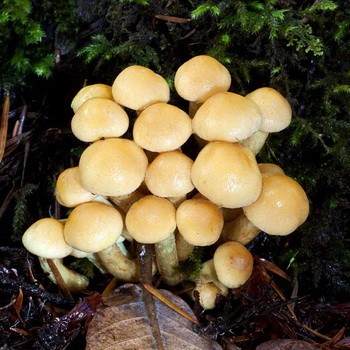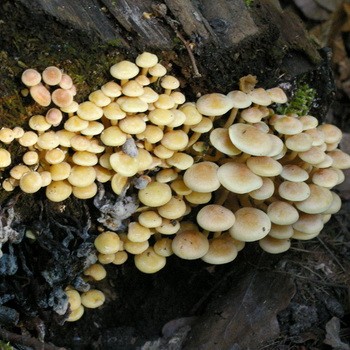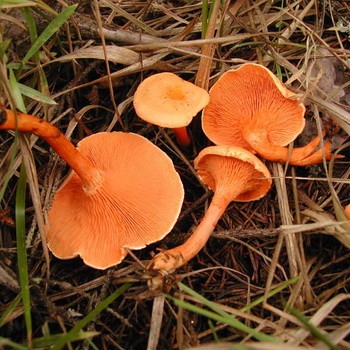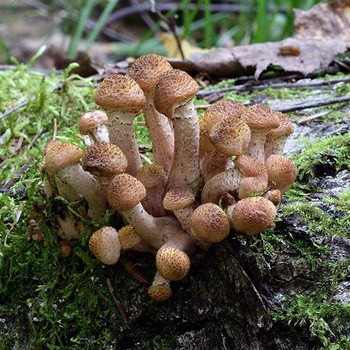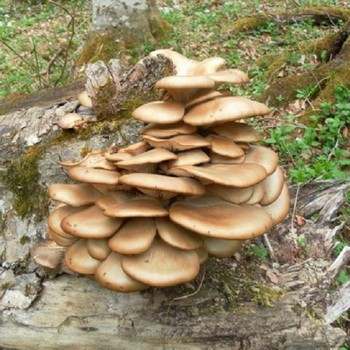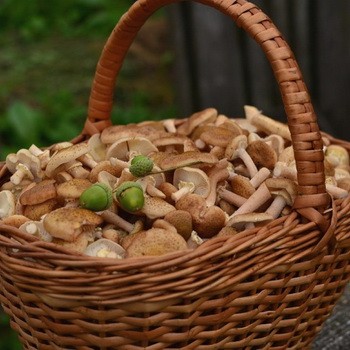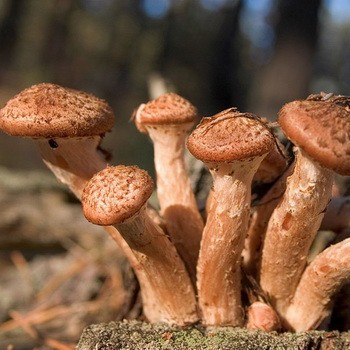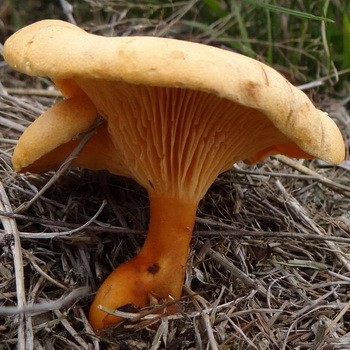Types of poisonous mushrooms and how to distinguish them from edible mushrooms
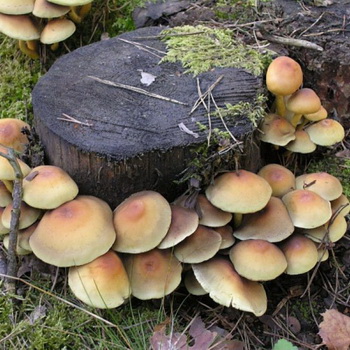
Every year, in anticipation of gathering mushrooms, most novice mushroom pickers begin to wonder what this or that representative of this species looks like. Such an interest is fully justified, because it is necessary not only to know, but to correctly distinguish between “good” fruiting bodies and “bad” ones. Otherwise, the consequences of eating a false mushroom can be sad.
Content
- Poisonous mushrooms are poisonous mushrooms or not?
- Poisonous substances in false mushrooms
- How poisonous are the false mushrooms and how do they look?
- Poisonous autumn mushrooms: photos and distinguishing features of false mushrooms
- Summer poisonous brick red mushrooms
- What other mushrooms are poisonous?
- How can I check whether poisonous mushrooms are mushrooms or not?
- How to identify poisonous mushrooms mushrooms during cooking?
Poisonous mushrooms are poisonous mushrooms or not?
But are all false mushrooms poisonous or not? Interestingly, even an edible mushroom may well become poisonous if you do not follow the rules for its storage, as well as carry out improper processing. For example, everyone knows that fruiting bodies are a perishable product, so it is strictly forbidden to store them fresh for a long time. Otherwise, they will begin to blacken very quickly and release harmful substances that are hazardous to health. In addition, it is important to make the correct preparation for processing, and for each type of mushroom it is different. Therefore, it is not always even a false honey agaric that can be called a poisonous mushroom.
Inedible fruiting bodies will not necessarily be considered poisonous. This type includes non-toxic mushrooms that have a bad taste and an unpleasant odor. In this regard, it is simply not eaten.
In this article, you will learn about poisonous mushrooms and honey mushrooms and see their photos that help to examine in detail their appearance. In addition, the information provided will help you learn to distinguish false mushrooms from edible ones.
Poisonous substances in false mushrooms
False or poisonous species of mushrooms are mushrooms that are very similar in appearance to edible ones. These two representatives have much in common, including habitat and growth characteristics. False mushrooms can settle even on the same site with edible. In addition, both of them grow as whole families on stumps, deforestation, felled and dead trees. Some types of false mushrooms are poisonous, others are inedible, and others are conditionally edible. However, all mushroom pickers are strongly discouraged from experimenting with picking such mushrooms. Anyone, especially a novice lover of “silent hunting”, needs to remember the main rule for the successful use of forest gifts: “If you have the slightest doubt, pass by!” Take only those mushrooms in which you are absolutely sure. False mushrooms emit toxic substances, so carelessness or lack of information can play a trick on your health.
So, are all false mushrooms poisonous? It turns out that conditionally edible mushrooms are also classified as false species, which, subject to a certain heat treatment, can be eaten.However, you must be very careful, because even here it is impossible to give an absolute guarantee of security.
How poisonous are the false mushrooms and how do they look?
Moreover, the mushroom of honey agarics is able to partially modify. Such transformations are the result of changes in weather conditions, and also depend on the type of wood on which the fruiting body grows. Mushroom pickers with experience are often already ready for such "surprises", so they turn to additional signs. But some beginners, unfortunately, do not always realize how poisonous the false mushrooms are, so they often ignore additional signs, limiting themselves only to superficial knowledge. In this case, it is highly desirable even before you go for your first harvest, to take the "course of the young fighter" under the guidance of an experienced mushroomer. By the way, it is not necessary to study the entire group of twins of each species. It is enough just to deepen your knowledge of one or two species, the most famous in a particular area. If we know what appearance the edible species of fruiting bodies have, then we need to determine how poisonous mushrooms look like? After all, as already mentioned, false representatives can be very similar to their edible "brothers."
We suggest you familiarize yourself with a detailed description and photos of poisonous mushrooms, which are the most common in most territories of the Russian Federation.
Poisonous autumn mushrooms: photos and distinguishing features of false mushrooms
Autumn honey agaric is considered the most popular among all other species of its kind. He is very loved for his high nutritional value, taste and aroma. However, poisonous twins are found in autumn mushrooms: false-sulfur foil sulfur-yellow and brick red.

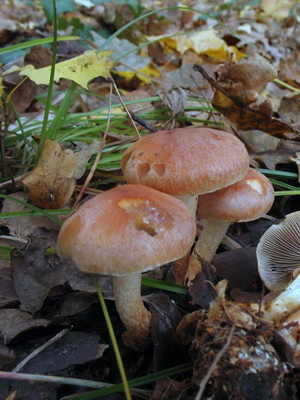
Latin name: Hypholoma fasciculare.
Family: Strophariaceae.
Synonyms: Naematoloma fasciculare, Geophila fascicularis, Agaricus fascicularis, Dryophila fascicularis, Pratella fascicularis, Psilocybe fascicularis.
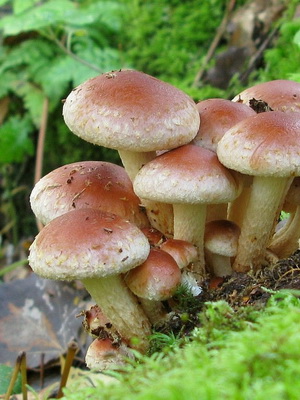
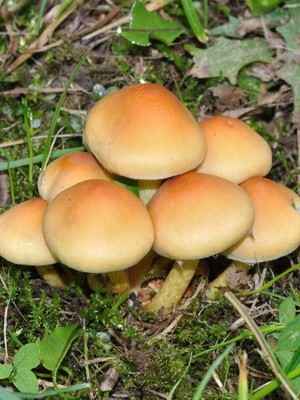
Hat: convex, fleshy, at a young age, the size is 4-6 cm in diameter. As they grow older, the cap straightens slightly and increases in size by 1-2 cm. The surface of the cap is yellow, in the center there is a reddish or rusty-brown spot. A closer look at the edges of the cap shows a greenish tint, and the fruit body itself in these places has barely noticeable remains of the coverlet.
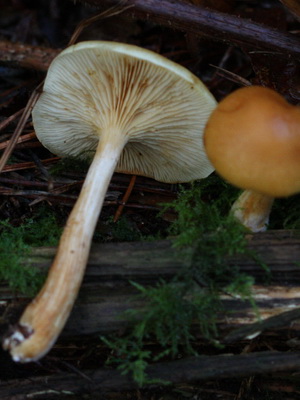
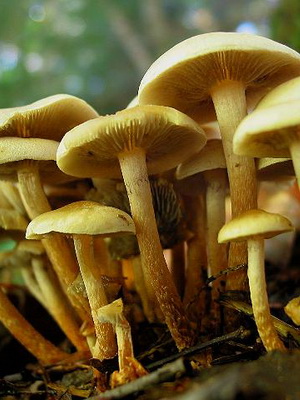
Leg: high, up to 10 cm, cylindrical, hollow, often curved. It has a yellow color, a brownish tint appears closer to the base. A distinctive feature of the poisonous mushroom of the false honeycomb of sulfur-yellow is the absence of a skirt ring, which is inherent in edible species.
Pulp: whitish or light yellow, has a strong bitterness and an unpleasant odor.
Records: thin, densely arranged, greenish or olive-black, adhered to the stem.
Edibility: the mushroom is poisonous. When eaten after 2-4 hours, the first signs of poisoning appear.
Spread: grows by families on old and rotten stumps of mainly deciduous trees. Also found at the base of living and dead trunks, as well as on fallen branches.
Harvest Season: August-October, with favorable weather, grows until mid-November.
We offer you to see photos of poisonous mushrooms, similar to autumn species:
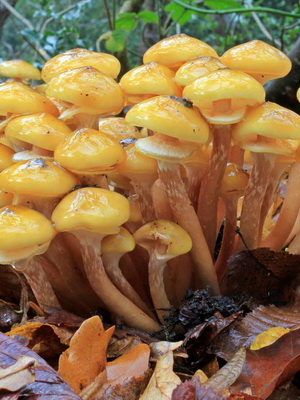
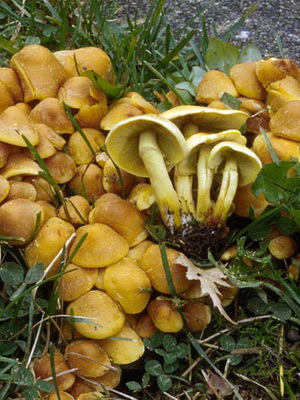
Summer poisonous brick red mushrooms
Latin name: Hypholoma lateritium.
Family: Strophariaceae.
Synonyms: Agaricus carneolus, Agaricus perplexus, Deconica squamosa, Geophila sublateritia, Hypholoma perplexum, Hypholoma sublateritium, Naematoloma sublateritium, Psilocybe lateritia.
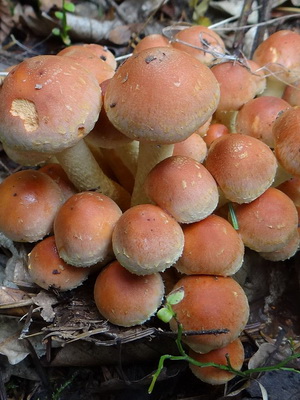
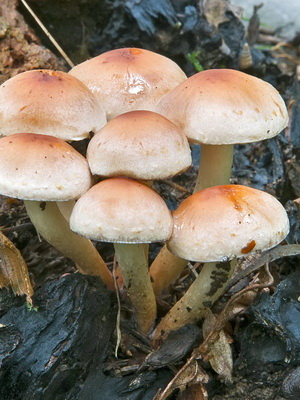
Hat: diameter from 4 to 10 cm, spherical, with age revealed. Dense, fleshy, red-brown or yellow-brown. The crown has a much darker shade than the primary color.
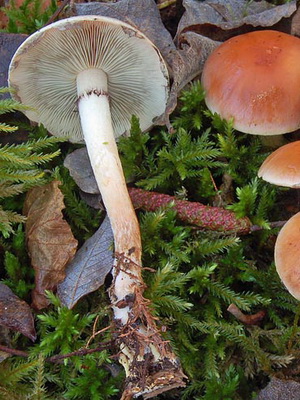

Leg: up to 10 cm in height, up to 1.5 cm in thickness, even, at the base - narrowed, brown. The rest of the leg is yellow; the ring is missing.
Pulp: dense, dark yellow, bitter, unpleasantly smelling. It’s better not to taste it, as you can be poisoned.
Records: dense, narrowly grown, with a light gray tint in young individuals and olive gray in old ones.
Edibility: poisonous, although some experts classify it as conditionally edible.
Spread: deciduous and coniferous forests of Eurasia and North America. It grows from July to October by large families on stumps, fallen trees, forest felling, and also near the roots of trees.
I must say that the above poisonous mushrooms can be confused with summer species, and not just with autumn ones. Therefore, for starters, it is recommended to find out what real edible mushrooms look like, and then proceed to study material about false counterparts.
What other mushrooms are poisonous?
What other poisonous mushrooms can be found in our territory? No less well-known is the False film of Candol, also known as Psatirella Candol. First of all, it is important to remember that this species is very insidious. The fact is that everything affects his appearance - age, habitat, air temperature, humidity. In this case, only an experienced mushroom picker can know how to distinguish between poisonous mushrooms and edible mushrooms.
We offer to see this with the help of a photo and description.
Latin name: Psathyrella candolleana.
Family: Psatirella.
Synonyms: Agaricus violaceolamellatus, Agaricus candolleanus, Drosophila candolleana, Hypholoma candolleanum, Psathyra candolleanus; Candolle's False Foam
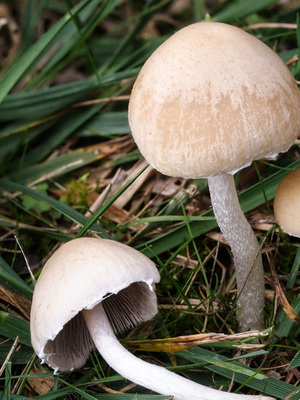
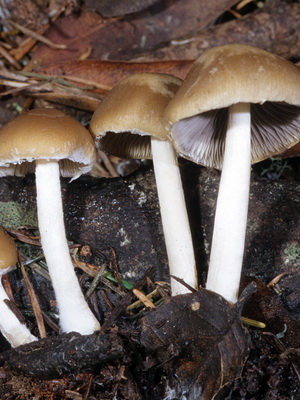
Hat: hemispherical, 4-8 cm in diameter, becomes bell-shaped as it grows older, then flat. In the center there is a tubercle, the edges are wavy-sinuous, often cracked. The surface is almost smooth with small brown or yellow-brown scales that disappear pretty quickly. The color of the hat is yellow or cream, the surface itself is dull, dry, the edges are quite brittle. The picture below clearly shows how poisonous mushrooms of this species look.
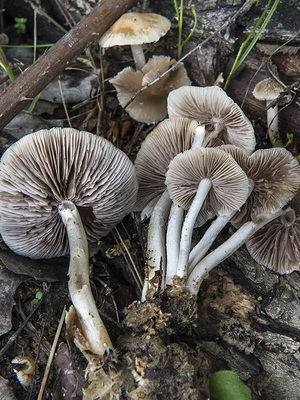
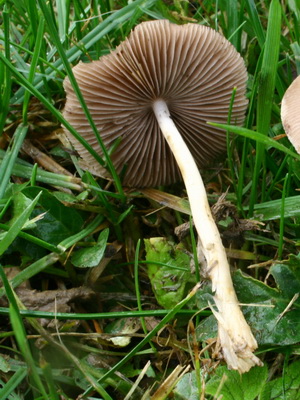
Leg: 4-10 cm in length, 0.5 cm in thickness, smooth, hollow, easily breaking. It thickens to the base, sometimes a root-like appendage is observed. White or delicate cream color, velvety at the top.
Pulp: whitish, brittle, thin, has no pronounced taste or smell.
Records: grown, frequent, thin, change color from white to gray-violet and even dark brown as they grow.
Edibility: poisonous mushroom, however, discussions about whether mushrooms of this species are poisonous continue to this day. Sometimes it is classified as conditionally edible.
Spread: growing in the Eurasian continent and North America. Selects hardwood and soil near stumps. It grows in large groups, sometimes single individuals are found. The season of abundant fruiting begins in June and ends at the end of September.
How can I check whether poisonous mushrooms are mushrooms or not?
How can edible mushrooms be distinguished from poisonous mushrooms, and what signs exist for this? The question is quite natural, because hardly anyone wants to harm their health by eating one of these fruiting bodies. The most correct and logical way to understand this issue will be a trip to the forest together with an experienced mushroom picker. However, no one has yet forbidden to get a preliminary consultation on the Internet by comparing photos of edible and poisonous mushrooms:
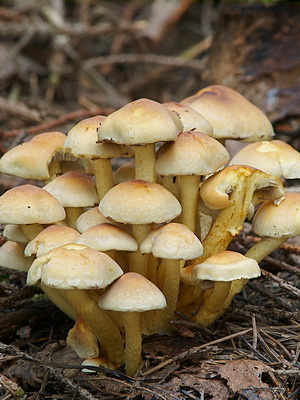
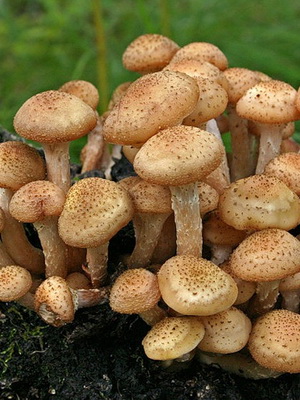
The main distinguishing feature of these mushrooms is the presence of a skirt ring, which is not the case with false ones. However, it is worth remembering that old overgrown fruiting bodies may lose this trait, despite its edibility.
In addition, the color will always be brighter in poisonous fruiting bodies, and more modest in edible representatives. How else can you check whether poisonous mushrooms are mushrooms or not? You can smell the fruit body and even lightly touch the pulp with your tongue. The smell of a false honey agaric is unpleasant, and the flesh is bitter. In addition, poisonous species do not have scales on their heads; their surface is often completely smooth. However, the presence of such “flakes” is distinguished only by young mushrooms, whereas in old specimens they completely disappear.
Look also at the color of the plates under the hat: in real mushrooms they are white or cream, and in false mushrooms they are yellow, as they age, they are greenish. In addition, the place of cut in false mushrooms instantly becomes brown-black, while in edible mushrooms it darkens, and gradually.
How to identify poisonous mushrooms mushrooms during cooking?
Is it possible to identify poisonous mushrooms during cooking and how to do it? There are several ways, but you cannot say for sure that they are all effective. For example, you can put a silver product in water. If it darkens, it means that the mushroom is poisonous. However, silver can darken from edible species.
There is also an opinion that you can put in a pan a peeled head of onion or garlic. In the presence of toxic substances, the product should acquire a brown or blue tint. Although it is noted that the shade can change when exposed to edible fruiting bodies.
Some add milk while boiling mushrooms, believing that toxic substances will cause the product to curl. However, this feature does not come from the presence of hazardous enzymes.
